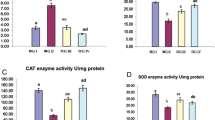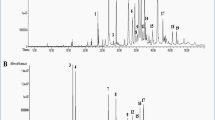Summary
Tea (Camellia sinensis) is one of the most widely used beverages worldwide and tea consumption has been shown to have an inverse correlation to the incidence of human cancers in epidemiological and experimental studies. In the present study, the protective effects of green tea polyphenols (GTP) and black tea polyphenols (BTP) in Wistar rats were assessed by medium-term bioassay, using altered hepatic foci (AHF) as end point. Animals were exposed to a single dose of diethylnitrosamine (DEN; 200 mg/kg body weight intraperitoneally), and GTP (1%) and BTP (1%) were then administered orally together with 0.05% 2-acetyl aminofluorene (2-AAF) crushed and mixed in the diet for 8 weeks. Numbers of AHF were scored and analyzed by quantitative stereology using the Image analysis system from frozen liver tissue sections. Tea polyphenol supplementation resulted in a significant protection against AHF induction in Wistar rats. In addition, levels of the positive biomarkers: γ-glutamyl transpeptidase and glutathione-S-transferase (placental form) were reduced with GTP and BTP supplementation. Levels of the negative biomarkers adenosine triphosphatase and glucose-6-phosphatase were also restored by GTP and BTP administration. Thus, these results show the hepatoprotective effects of GTP and BTP against DEN- and 2-AAF-induced AHF development.


Similar content being viewed by others
Abbreviations
- 2-AAF:
-
2-Acetyl aminofluorene
- AHF:
-
Altered hepatic foci
- BTP:
-
Black tea polyphenols
- DEN:
-
Diethylnitrosamine
- GGT:
-
γ-Glutamyl transpeptidase
- GTP:
-
Green tea polyphenols
- GST-P:
-
Glutathione-S-transferase placental form
- G6Pase:
-
Glucose-6-phosphatase
- ATPase:
-
Adenosine triphosphatase
References
Kamaraj S, Ramakrishnan G, Anandakumar P, Jagan S, Devaki T (2008) Antioxidant and anticancer efficacy of hesperidin in benzo(a)pyrene induced lung carcinogenesis in mice. Invest New Drugs (in press)
Mukhtar H, Ahmad N (1999) Green tea in chemoprevention of cancer. Toxicol Sci 52:111–117
Yanagida A, Shoji A, Shibusawa Y, Shindo H, Tagashira M, Ikeda M, Ito Y (2006) Analytical separation of tea catechins and food-related polyphenols by high-speed counter-current chromatography. J Chromatogr A 1112:195–201 doi:10.1016/j.chroma.2005.09.086
Mukhtar H, Ahmad N (2000) Tea polyphenols: prevention of cancer and optimizing health. Am J Clin Nutr 7:1698–1702
Zaveri NT (2006) Green tea and its polyphenolic catechins: medicinal uses in cancer and noncancer applications. Life Sci 78:2073–2080 doi:10.1016/j.lfs.2005.12.006
Imai K, Nakachi K (1995) Cross sectional study of effects of drinking green tea on cardiovascular and liver diseases. BMJ 310:693–696
Weisburger JH (1990) Tea and health: the underlying mechanisms. Proc Soc Exp Biol Med 220:271–275 doi:10.1046/j.1525-1373.1999.d01-46.x
Vinson JA (2000) Black and green tea and heart disease: a review. Biofactors 13:127–132
Bastianetto S, Yao ZX, Papadopoulos V, Quirion R (2006) Neuroprotective effects of green and black teas and their catechin gallate esters against beta-amyloid-induced toxicity. Eur J Neurosci 23:55–64 doi:10.1111/j.1460-9568.2005.04532.x
Dryden GW, Song M, McClain C (2006) Polyphenols and gastrointestinal diseases. Curr Opin Gastroenterol 22:165–170 doi:10.1097/01.mog.0000208463.69266.8c
Javed S, Mehrotra NK, Shukla Y (1998) Chemopreventive effects of black tea polyphenols in mouse skin model of carcinogenesis. Biomed Environ Sci 11:307–313
Qi L, Han C (1998) Induction of NAD(P)H: quinone reductase by anticarcinogenic ingredients of tea. Wei Sheng Yan Jiu 27:323–326
Javed S, Shukla Y (2000) Effects of black tea extract on transplantable and solid tumors in Swiss albino mice. Biomed Environ Sci 13:213–218
Banerjee S, Manna S, Saha P, Panda CK, Das S (2005) Black tea polyphenols suppress cell proliferation and induce apoptosis during benzo(a)pyrene-induced lung carcinogenesis. Eur J Cancer Prev 14:215–221 doi:10.1097/00008469-200506000-00004
Mu LN, Zhou XF, Ding BG, Wang RH, Zhang ZF, Chen CW, Wei GR, Zhou XM, Jiang QW, Yu SZ (2003) A case-control study on drinking green tea and decreasing risk of cancers in the alimentary canal among cigarette smokers and alcohol drinkers. Zhonghua Liu Xing Bing Xue Za Zhi 24:192–195
Thangapazham RL, Singh AK, Sharma A, Warren J, Gaddipati JP, Maheshwari RK (2007) Green tea polyphenols and its constituent epigallocatechin gallate inhibits proliferation of human breast cancer cells in vitro and in vivo. Cancer Lett 245:232–241 doi:10.1016/j.canlet.2006.01.027
Mantena SK, Meeran SM, Elmets CA, Katiyar SK (2007) Orally administered green tea polyphenols prevent ultraviolet radiation-induced skin cancer in mice through activation of cytotoxic T cells and inhibition of angiogenesis in tumors. J Nutr 135:2871–2877
Hastak K, Gupta S, Ahmad N, Agarwal MK, Agarwal ML, Mukhtar H (2003) Role of p53 and NF-kappaB in epigallocatechin-3-gallate-induced apoptosis of LNCaP cells. Oncogene 22:4851–4859 doi:10.1038/sj.onc.1206708
Ermakowa S, Choi BY, Choi HS, Kang BS, Bode AM, Dong Z (2005) The intermediate filament protein vimentin is a new target for epigallocatechin gallate. J Biol Chem 280:16882–16890 doi:10.1074/jbc.M414185200
Lambert JD, Yang CS (2003) Mechanisms of cancer prevention by tea constituents. J Nutr 133:3262–3267
Feng Q, Kumagai T, Toni Y, Nakamura Y, Osawa T, Uchida K (2001) Anticarcinogenic antioxidants as inhibitors against intracellular oxidative stress. Free Radic Res 35:779–788 doi:10.1080/10715760100301281
Kalra N, Prasad S, Shukla Y (2005) Antioxidant potential of black tea against 7,12-dimethylbenz(a)anthracene-induced oxidative stress in Swiss albino mice. J Environ Pathol Toxicol Oncol 24:105–114 doi:10.1615/JEnvPathToxOncol.v24.i2.40
Maliakal PP, Coville PF, Wanwimolruk S (2001) Tea consumption modulates hepatic drug metabolizing enzymes in Wistar rats. J Pharm Pharmacol 53:569–577 doi:10.1211/0022357011775695
Matsumoto N, Kohri T, Okushio K, Hara Y (1996) Inhibitory effects of tea catechins, black tea extract and oolong tea extract on hepatocarcinogenesis in rat. Jpn J Cancer Res 87:1034–1038
Shukla Y, Kalra N, Katiyar S, Siddiqui IA, Arora A (2004) Chemopreventive effect of indole-3-carbinol on induction of preneoplastic altered hepatic foci. Nutr Cancer 50:214–220 doi:10.1207/s15327914nc5002_12
Singh A, Arora A, Shukla Y (2004) Modulation of altered hepatic foci induction by diallyl sulphide in Wistar rats. Eur J Cancer Prev 13:263–269 doi:10.1097/01.cej.0000127633.89678.fb
Arora A, Shukla Y (2004) Induction of preneoplastic altered hepatic foci following dietary sulphur supplementation. Hum Exp Toxicol 23:229–234 doi:10.1191/0960327104ht435oa
Ito N, Tamano S, Shirai T (2003) A medium-term rat liver bioassay for rapid in vivo detection of carcinogenic potential of chemicals. Cancer Sci 94:3–8 doi:10.1111/j.1349-7006.2003.tb01343.x
Pinheiro F, Faria RR, de-Camrago JLV, Spinardi-Barbisan ALT, da-Eira AF (2003) Chemoprevention of pre neoplastic liver foci development by dietary mushroom Agaricus blazei murrill in the rat. Food Chem Toxicol 41:1543–1550 doi:10.1016/S0278-6915(03)00171-6
Shukla Y, Arora A (2003) Suppression of altered hepatic foci development by curcumin in Wistar rats. Nutr Cancer 45:53–59 doi:10.1207/S15327914NC4501_7
Tatematsu M, Mera Y, Inoue T, Satoh K, Sato K, Ito N (1988) Stable phenotypic expression of glutathione S-transferase placental type and unstable phenotypic expression of γ-glutamyl transferase in rat liver preneoplastic and neoplastioc lesions. Carcinogenesis 9:215–220 doi:10.1093/carcin/9.2.215
Rutenberg AM, Kim H, Fischbeion JW, Hanker JS, Wasserkrug HL, Seligman AM (1969) Histochemical and ultrastructural demonstration of gamma glutamyl transpeptidase activity. J Histochem Cytochem 17:17–26
Weishestein M, Meisel E (1956) Histochemical detection of glucose 6 phosphatase activity. J Histochem 4:492–498
Glauert HP, Beer D, Rao MS, Schwarz M, Xu YD, Goldsworthy TL, Coloma J, Pitot HC (1986) Induction of altered hepatic foci in rats by the administration of hypolipidemic peroxisome proliferators alone or following a single dose of diethylnitrosamine. Cancer Res 46:4601–4606
Hayes JD, Pulford DJ (1995) The glutathione S-transferase supergene family: regulation of GST and the contribution of the isoenzymes to cancer chemoprotection and drug resistance. Crit Rev Biochem Mol Biol 30:445–600 doi:10.3109/10409239509083491
Yusof YA, Yan KL, Hussain SN (2003) Immunohistochemical expression of pi class glutathione S-transferase and alfa-fetoprotein in hepatocellular carcinoma and chronic liver disease. Anal Quant Cytol Histol 25:332–338
Yoxall V, Umachandran M, Wilson J, Kentish P, Loannides C (2004) Black tea intake modulates the excretion of urinary mutagens in rats exposed to 6-aminochrysene: induction of cytochromes P450 by 6-aminochrysene in the rat. Mutagenesis 20:23–28 doi:10.1093/mutage/gei002
Krishnan R, Raghunathan R, Maru GB (2005) Effect of polymeric black tea polyphenols on benzo(a)pyrene [B(a)P]-induced cytocrome P450 1A1 and 1A2 in mice. Xenobiotica 35:671–682 doi:10.1080/00498250500202155
Taneja P, Arora A, Shukla Y (2003) Antimutagenic effects of black tea in the Salmonella typhimurium reverse mutation assay. Asian Pac J Cancer Prev 4:193–198
Santhosh KT, Swarnam J, Ramadasan K (2005) Potent suppressive effect of green tea polyphenols on tobacco-induced mutagenicity. Phytomedicine 12:216–220 doi:10.1016/j.phymed.2003.09.011
Shukla Y, Arora A, Taneja P (2003) Antigenotoxic potential of certain dietary constituents. Teratog Carcinog Mutagen 1:323–335 doi:10.1002/tcm.10059
Mukherjee P, Sarkar D, Sharma A (1997) Effects of dietary consumption of black tea infusion alone and in combination with known clastogens on mouse bone marrow chromosomes in vivo. Food Chem Toxicol 35:657–661 doi:10.1016/S0278-6915(97)00044-6
Acknowledgments
The authors would like to thank Dr Ashwani Kumar, Director, Indian Institute of Toxicology Research (Council of Scientific and Industrial Research, India) for his keen interest in the study and to the Indian Council of Medical Research (India) for providing fellowships to Ms Smita Srivastava and Mr Sahdeo Prasad. The authors would also like to thank Indfrag Limited (Bangalore, India) for generously providing GTP and BTP.
Author information
Authors and Affiliations
Corresponding author
Rights and permissions
About this article
Cite this article
Srivastava, S., Singh, M., Roy, P. et al. Inhibitory effect of tea polyphenols on hepatic preneoplastic foci in Wistar rats. Invest New Drugs 27, 526–533 (2009). https://doi.org/10.1007/s10637-008-9204-6
Received:
Accepted:
Published:
Issue Date:
DOI: https://doi.org/10.1007/s10637-008-9204-6




